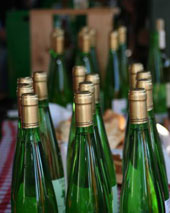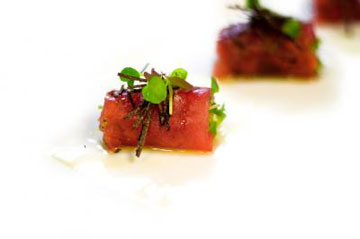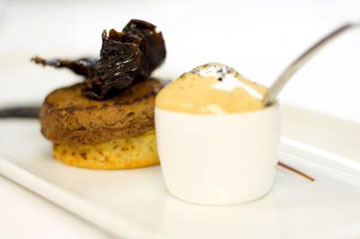Feeding nationalism (II/II)
:: Feeding nationalism (I / II)
Third, as the seemingly uncheckable advance of global capitalism continues to erode any significant degree of structural difference between societies, then, almost by default, cultural differences start to come to the fore. In the Basque Country traditional and distinctive forms of social structure and economic organization have fallen into decay, to be replaced by more globally common forms. In the process, cultural aspects of their way of life have become one of the few remaining means by which Basques can continue to proclaim their difference from other peoples. Pelota, the Basque ball game, supposedly the fastest ball game in the world, was for many decades an international banner of Basque cultural distinctiveness, as local players were hired to play in the frontones (pelota courts) of Miami, the American Midwest, Mexico, the Phillipines, and elsewhere. But the game has now been pushed aside as an exportable standard for Basqueness, for the sake of Basque cuisine. Why? Most likely because pelota is too strongly wedded to the old, overly traditional image of the Basque Country. In contrast, Basque cuisine can be presented as both traditional and new, both honestly simple and excitingly sophisticated. This Janus-like quality of Basque cuisine makes it a perfect commodity for sale in the international markets serving foodies, i.e. those members of the burgeoning middle classes in Western Europe, North America, and Australia who have made a cultivated knowledge of food the modern hallmark of social savoir-faire1. For all these reasons, the idea of ‘Basque cuisine’ has today taken on a greater significance for the nationalist struggle than it formerly held.

Fourth, recent interest in Basque cuisine and its ingredients chimes with the widespread rise of the environmentalist movement in the area. For today many Basque foods are seen to be as green as what remains of the verdant Basque countryside. They are regarded as traditional, ‘pure’ and ‘authentic’, a reassuring taste of the past, at a time when change, additives and pollutants seem otherwise to be becoming the norm. For instance Basque cider is presented by local panegyrists as ‘the ancestral drink of the Basques’, ‘authentic to its roots’, ‘produced in the most artesanal way possible’ using ‘autochthonous apples’, with hope for future increased sales pinned on ‘its radical naturalness’2. This desire for the markedly ‘authentic’ is one, modern way to fulfil a dream of countryside. Just as early nationalists lauded the landscape and promoted rural events presented in a traditionalist mode, so their latter-day, newly-urbanized successors celebrate the Basque countryside and commemorate their version of Basqueness in this novel geo-culinary fashion. We might say these eulogizers of the neo-rural are creating a taste of what should be, a flavour of a created past, heavily oaked with an oneiric nostalgia.
 Moreover,
in a bid to protect Basque markets against cheaper imports and to boost the
sense of local particularity, the Basque Government has created its own stamp
of authentic approval, the ‘Denominación de Origen Controlada’.
So far it has been applied to wines, cheese, capsicums, asparagus, red peppers
and a host of other foods. Their price is higher than that of their more mass-produced
competitors but one is meant here to be paying extra for the sake of a guaranteed
Basque product of certified origin. In this century Basque authorities have
as well started to promote the meat from autochthonous breeds of livestock
as ‘Productos de Calidad’. Their aims are dual: to maintain local
difference and genetic diversity in the face of a threatening standardization
stimulated by global forces; to support local cattle farmers dedicated to
the preservation of indigenous breeds, who can sell their meat as distinctive
and of high quality. Many local chefs are happy to come on board, as they
wish to produce dishes with ingredients which are both local and highly valued.
The ultimate aim is to renovate a sector of the Basque economy, both rural
(the herdsmen) and urban (the restauranteurs), by producing
prestigious products with a high-profit margin and a good Basque image, for
consumption both locally and beyond.3
Moreover,
in a bid to protect Basque markets against cheaper imports and to boost the
sense of local particularity, the Basque Government has created its own stamp
of authentic approval, the ‘Denominación de Origen Controlada’.
So far it has been applied to wines, cheese, capsicums, asparagus, red peppers
and a host of other foods. Their price is higher than that of their more mass-produced
competitors but one is meant here to be paying extra for the sake of a guaranteed
Basque product of certified origin. In this century Basque authorities have
as well started to promote the meat from autochthonous breeds of livestock
as ‘Productos de Calidad’. Their aims are dual: to maintain local
difference and genetic diversity in the face of a threatening standardization
stimulated by global forces; to support local cattle farmers dedicated to
the preservation of indigenous breeds, who can sell their meat as distinctive
and of high quality. Many local chefs are happy to come on board, as they
wish to produce dishes with ingredients which are both local and highly valued.
The ultimate aim is to renovate a sector of the Basque economy, both rural
(the herdsmen) and urban (the restauranteurs), by producing
prestigious products with a high-profit margin and a good Basque image, for
consumption both locally and beyond.3
But what lies behind the rhetoric, the promotional campaigns, and the striving for authenticity? For what the politicians and the publicists for Basque cuisine fail to mention is that the daily diet of the local populace is gradually becoming less and less distinctive, as fast-food outlets open throughout the area and hipermarkets replace corner stores4. Over the last twenty years, I have conducted a total of over four years’ fieldwork in a small Navarran village. Everyday when I am there I eat with my landlords, a smallholder and his family. Even though he himself produces a significant proportion of what we eat, the rest is bought in and much of that is industrially produced food: ham, cheese, frozen rings of squid in batter, ice cream, etc. Over the years the proportion of bought-in food has increased. I have checked this fact with other locals, who admit it is a general trend within their own homes. In other words, traditional Basque cuisine is becoming more and more of a rarity, even within this agricultural, food-producing area. Furthermore, within the area’s cities, producing traditional Basque dishes is coming to be seen as a luxury, as a hobby for those with sufficient income to afford the leisure time necessary to cook in the customary manner.

Some local journalists have been quick to pick up these points. Promotion of Basque cuisine is now so great that one reporter has complained of its use as ‘a throwing weapon’5. Another found some locals annoyed at outsiders’ association of Basques and good eating: ‘It’s as if here we did nothing else.’6 In the words of one Bilbao columnist:
The nationalists, almost always nostalgic for days which, in reality, have never been, are reluctant to accept the miserable truth of things, seeking difference in anything which crops up: marrows with denominación de origen for example...
The reality, televisual and cruel, true as a Biblical phrase, has overcome any difference. The Basque Country, for example, being a territory presumed to be of gastronomic refinement, congregates an ever increasing quantity of commercial macrocentres where adolescents and those who are unwilling to abandon that pitiless age, devour, day after day, cones of chips with ketchup, defrosted pizzas, onion rings, chicken à la Kentucky, plastic salads and dubious hamburgers from any MacDonalds, Burger King, Pizza Guss or Telechef.7
Other commentators have pointed out how some prized Basque foods are now Basque only in name. Today, the sloes (pacharán) for the distinctive and highly popular local drink pacharán (sloe anis) come mostly from Eastern Europe; the cod for bacalao is no longer trawled by Basque fishermen but imported, already salted, from Iceland; elvers (angulas) are now so expensive that they are being replaced by gulas: Japanese surimi fishmeat processed industrially into elver-like shapes, each tinted with a touch of squid ink.8

Some opponents of Basque nationalism have adopted a slightly different tack,
by promoting a regional cuisine whose borders cross-cut those of the general
Basque area. Thus the Navarran Government and a significant number of locals
are now keen to substantiate a sense of ‘Navarraness’ by developing
its cultural distinctiveness, including its foodways. Hence, in the last decade,
several subsidized books have appeared on ‘Navarran cuisine’,
a promotional tour of Navarran gastronomy was held throughout Spain, and regional
journalists devote feet of column inches to articles lauding local products
and their traditional methods of production. In the late 1980s,
local chefs even came up with their own answer to la nueva cocina vasca by
collectively launching, with the aid of the regional press, ‘la nueva
cocina navarra’9. It is noteworthy
that the only event in the 2004 calendar of the London branch of the Instituto
Cervantes (the Spanish Government body which promotes Spanish culture overseas)
which included a free reception was the talk on Navarre given by the President
of its Deputation: the Instituto programme stated that his ‘comprehensive
analysis of Navarre today’ would be followed by ‘a Food Sampling
Session of Navarrese top quality products including asparagus, roasted red
peppers, cheese, wines and liqueurs’.
These sectional tactics for fighting cultural wars lay starkly bare the political
agenda behind the Basque Government’s support for Basque cuisine.
....................... |
In sum, ‘Basque cuisine’ is not an innocent term, used for narrowly gastronomic reasons. It is a constructed category, exploited by a variety of different interest groups: by nationalist politicians who wish to strengthen their own party’s position, by chefs keen to promote their own careers and to fortify the standing of their own profession, and by journalists seeking copy to sell their papers. It is also an evolving category, whose content-despite claims to timelessness-develops over time, and whose ingredients may well no longer come from the Basque Country. Moreover, it is a contested category, capable of attracting criticism as well as eulogistic support. It is at the same time an idea detached from the daily dietary reality of the majority of Basques. As such, it is more of a hope than a description, an aim rather than a classification. Less ‘This is the way the Basques eat’ than ‘This is the way we would like the Basques to eat’.
1 Izagirre 1997: 109. On the international rise of ‘foodie-ism’, see Barr and Levy 1984, MacClancy 1992: 208-13. On the commercial profitability of ‘Basque’ restaurants in Barcelona see Medina 2002.
2 Aguirre 1996: 6, 70, 131-2. Local cheeses, produced in a time-honoured manner by shepherds in mountainous areas, have become a particular focus of interest. Every year, on the last Sunday of August in Uharte-Arakil, northwestern Navarre, the municipality holds a competition for the best artesanal cheese, followed by its auction of the winning item. The final price can reach several thousand pounds (see Hualde, Pagola and Torre 1989).
3 Amezaga 2006.
4 Bengoa n.d.
5 M 21 vi 99: 16.
6 El País 9 xi 1990: 11.
7 Bolland 1999.
8 Navarra Hoy 22 xi 1986: xxvi; Kurlansky 1997: 211-3; 1999: 259-62.
9 Recent books on Navarran cuisine include Abad 1999, Abad and Ruiz 1986, Sarobe 1995. Newspaper articles include El Diario de Navarra ‘Gastronomía Navarra’, Número extraordinario, 22 xi 1982; Navarra Hoy 22 xi 1986: xxi, xxvi; 22 ii 1987; 6 iii 1987; 8 iii 1987; 14 vi 1987: 6; 22 viii 1986: 11.
Este texto pertenece al libro “Expressing Identities in the Basque Arena” publicado por James Currey Publisher (Oxford). El libro saldrá en Octubre de 2007.
:: Feeding nationalism (I / II)
euskonews@euskonews.com
